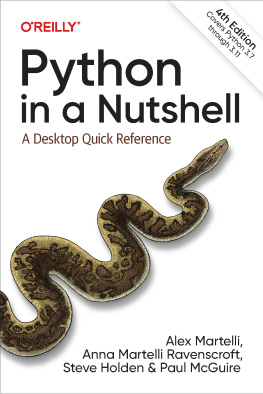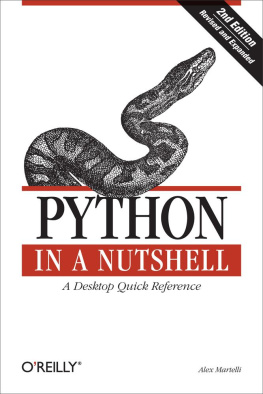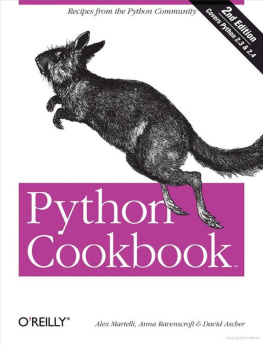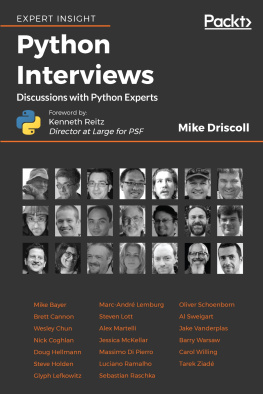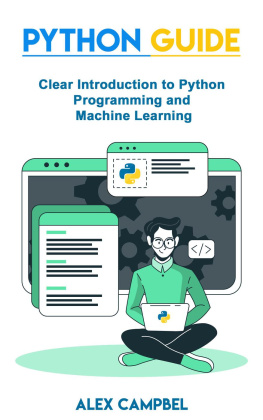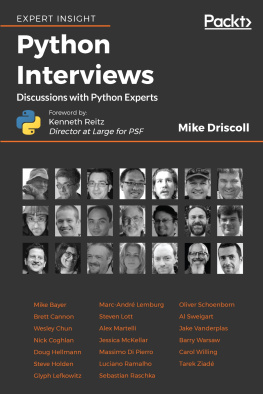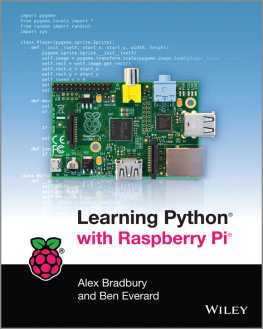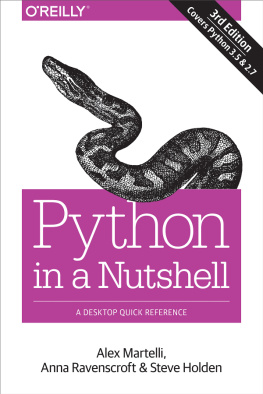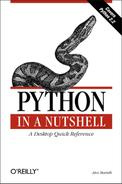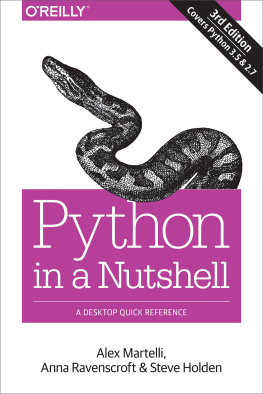Alex Martelli - Python in a Nutshell
Here you can read online Alex Martelli - Python in a Nutshell full text of the book (entire story) in english for free. Download pdf and epub, get meaning, cover and reviews about this ebook. year: 2023, publisher: OReilly Media, Inc., genre: Home and family. Description of the work, (preface) as well as reviews are available. Best literature library LitArk.com created for fans of good reading and offers a wide selection of genres:
Romance novel
Science fiction
Adventure
Detective
Science
History
Home and family
Prose
Art
Politics
Computer
Non-fiction
Religion
Business
Children
Humor
Choose a favorite category and find really read worthwhile books. Enjoy immersion in the world of imagination, feel the emotions of the characters or learn something new for yourself, make an fascinating discovery.
- Book:Python in a Nutshell
- Author:
- Publisher:OReilly Media, Inc.
- Genre:
- Year:2023
- Rating:3 / 5
- Favourites:Add to favourites
- Your mark:
- 60
- 1
- 2
- 3
- 4
- 5
Python in a Nutshell: summary, description and annotation
We offer to read an annotation, description, summary or preface (depends on what the author of the book "Python in a Nutshell" wrote himself). If you haven't found the necessary information about the book — write in the comments, we will try to find it.
Python in a Nutshell — read online for free the complete book (whole text) full work
Below is the text of the book, divided by pages. System saving the place of the last page read, allows you to conveniently read the book "Python in a Nutshell" online for free, without having to search again every time where you left off. Put a bookmark, and you can go to the page where you finished reading at any time.
Font size:
Interval:
Bookmark:

by Alex Martelli , Anna Martelli Ravenscroft , Steve Holden , and Paul McGuire
Copyright 2023 Alex Martelli, Anna Martelli Ravenscroft, Steve Holden, and Paul McGuire. All rights reserved.
Printed in the United States of America.
Published by OReilly Media, Inc. , 1005 Gravenstein Highway North, Sebastopol, CA 95472.
OReilly books may be purchased for educational, business, or sales promotional use. Online editions are also available for most titles (http://oreilly.com). For more information, contact our corporate/institutional sales department: 800-998-9938 or corporate@oreilly.com .
- Acquisitions Editor: Brian Guerin
- Development Editor: Angela Rufino
- Production Editor: Christopher Faucher
- Copyeditor: Rachel Head
- Proofreader: Sonia Saruba
- Indexer: Judith McConville
- Interior Designer: David Futato
- Cover Designer: Karen Montgomery
- Illustrator: OReilly Media, Inc.
- March 2003: First Edition
- July 2006: Second Edition
- April 2017: Third Edition
- January 2023: Fourth Edition
- 2023-01-09: First Release
See https://www.oreilly.com/catalog/errata.csp?isbn=0636920602804 for release details.
The OReilly logo is a registered trademark of OReilly Media, Inc. Python in a Nutshell, the cover image, and related trade dress are trademarks of OReilly Media, Inc.
While the publisher and the authors have used good faith efforts to ensure that the information and instructions contained in this work are accurate, the publisher and the authors disclaim all responsibility for errors or omissions, including without limitation responsibility for damages resulting from the use of or reliance on this work. Use of the information and instructions contained in this work is at your own risk. If any code samples or other technology this work contains or describes is subject to open source licenses or the intellectual property rights of others, it is your responsibility to ensure that your use thereof complies with such licenses and/or rights.
978-1-098-11355-1
[LSI]
The Python programming language reconciles many apparent contradictions: elegant yet pragmatic, simple yet powerful, its very high-level yet doesnt get in your way when you need to fiddle with bits and bytes, and its suitable for novice programmers and great for experts, too.
This book is intended for programmers with some previous exposure to Python, as well as experienced programmers coming to Python for the first time from other languages. It provides a quick reference to Python itself, the most commonly used parts of its vast standard library, and a few of the most popular and useful third-party modules and packages. The Python ecosystem has grown so much in richness, scope, and complexity that a single volume can no longer reasonably hope to be encyclopedic. Still, the book covers a wide range of application areas, including web and network programming, XML handling, database interactions, and high-speed numeric computing. It also explores Pythons cross-platform capabilities and the basics of extending Python and embedding it in other applications.
While you can read this volume linearly from the beginning, we also aim for it to be a useful reference for the working programmer. You may choose to use the index to locate items of interest, or to read specific chapters for coverage of their particular topics. However you use it, we sincerely hope you enjoy reading what represents the fruit of the best part of a years work for the team.
The book has five parts, as follows.
Font size:
Interval:
Bookmark:
Similar books «Python in a Nutshell»
Look at similar books to Python in a Nutshell. We have selected literature similar in name and meaning in the hope of providing readers with more options to find new, interesting, not yet read works.
Discussion, reviews of the book Python in a Nutshell and just readers' own opinions. Leave your comments, write what you think about the work, its meaning or the main characters. Specify what exactly you liked and what you didn't like, and why you think so.

